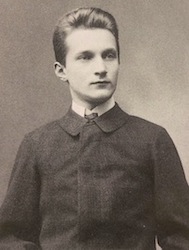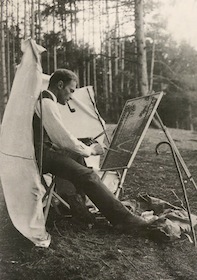Biography

Ernst Nepo was born Ernst Nepomucky in Dauba, Bohemia, the son of the teacher Josef Nepomucky and his wife Emilie Köcher on October 17, 1895. The artist shortened his surname to Nepo in 1920. From 1909 to 1913 he traveled to the Kunstgewerbeschule in Teplitz-Schönau. In 1909 he met Rudolf Lehnert. First internships at a joiner's workshop and a metalwork shop. In 1913 the artist studied at the Kunstgewerbeschule in Vienna along with Alfred Roller, Adolf Böhm and Oskar Strnad.
After the outbreak of the First World War on December 1, 1914 Nepo volunteered and joined the Tiroler Kaiserjägerregiment where he was deployed to Galicia. In 1915 he was stationed on the South Tyrolean front. In 1917 he had his first solo exhibition at the Kunsthandlung Czichna in Innsbruck. At the front, he meets the artist Alphons Schnegg, from Innsbruck and, after the war, in 1918 Schnegg returned to Innsbruck with Ernst Nepo. Together with Rudolf Lehnert and Herbert Gurschner they joined the artists’ group, Mühlauerkreis, named after the Innsbruck city district of Mühlau.

On September 29, 1920 Nepo married Bertha Thurner and their children, Lukas and Doris were born in 1922 and 1924, respectively. In 1925, Nepo and Schnegg were founding members of the artists’ association, Waage, along with Wilhelm Nicolaus Prachensky and Rudolf Lehnert. The group’s modern art focus presented a counter response to the well-established conservative Tyrolese art associations Künstlerbund and the Heimat. Nepo participated in the traveling exhibition Tyrolean Artists that was seen in Düsseldorf, Hamburg, and Munich. Nepo was a member of the Secession from 1927 to 1939. From 1928 the artist worked on various churches in Tyrol and Vorarlberg.
Between 1933 to 1937 Nepo worked as a stage designer for two Innsbruck theatres: the Stadttheater and the Exel, a popular folk theater. In the same period, in 1935 and 1936, Nepo created stage designs for the Passionsspiele in Thiersee. Ernst Nepo was appointed Regional Director of the Reichskammer der bildenden Künste in Tirol twice: from 1938-1939 and again in 1941-1943. In 1939 he was a member of the Künstlerhaus in Vienna.

On March 16, 1939 Nepo volunteered and joined the 'Mountain Regiment 136 Innsbruck'. He served in military operations in the Sudetenland, Poland, on the Western Front, in Norway and on the Russian Arctic Ocean Front. From 1944 to 1945, Nepo and other fellow artists guarded the munition warehouse at the Pulverturm in Innsbruck.
In the 1950s Ernst Nepo accepted portrait assignments and regularly returned to South Tyrol. Beginning in 1961 his artistic productivity was greatly reduced due to the artist suffering from serious illness. In 1965 he was awarded the Golden Laureate of the Viennese Künstlerhaus.
Ernst Nepo died in Innsbruck on August 26, 1971.
After experimenting in both the Secessionist school and Expressionism Ernst Nepo turned his efforts to the so-called 'New Objectivity' (Neue Sachlichkeit) and became one of Austria's most important representative of this art movement. The painter's works are found in numerous collections including in the Tiroler Landesmuseum in Innsbruck, the art collection of the University of Applied Arts in Vienna, and the Museion Museum of Modern Art in Bolzano.
